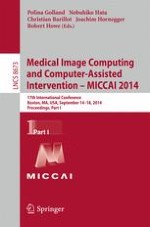2014 | Buch
Medical Image Computing and Computer-Assisted Intervention – MICCAI 2014
17th International Conference, Boston, MA, USA, September 14-18, 2014, Proceedings, Part I
herausgegeben von: Polina Golland, Nobuhiko Hata, Christian Barillot, Joachim Hornegger, Robert Howe
Verlag: Springer International Publishing
Buchreihe : Lecture Notes in Computer Science
